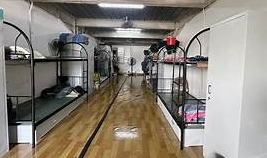New purpose-built dormitories offer improved living spaces, but full-scale transformation of migrant worker housing remains a challenge.
A new government-owned migrant worker dormitory, set to open in early 2026, offers improved living conditions and addresses long-standing concerns over worker housing. The purpose-built dormitory at Tukang Innovation Lane in Jurong is the first of two planned by the Ministry of Manpower (MOM), designed with consultation from migrant workers themselves. Mr. Sumun Biswas, a Bangladeshi hydraulic operator, expressed his satisfaction with the facility, highlighting features such as single beds, private spaces for personal calls, en-suite toilets, and free Wi-Fi—an exciting development for many workers involved in the design process.
This new dorm marks a significant step towards improving migrant worker housing in Singapore. Since the COVID-19 pandemic exposed the poor conditions of many dormitories, MOM has taken strides to improve living environments. In 2021, MOM introduced new regulatory standards for newly built dormitories, including a cap of 12 residents per room, a minimum of 4.2 square meters of personal space per resident, and mandatory en-suite toilets.
However, challenges remain. While the Tukang dorm sets a new benchmark, the transformation of all existing dormitories will take time. Many current dorms, facing infrastructural limitations, have until 2040 to meet the full set of updated standards. MOM has allowed a phased approach, prioritizing the gradual upgrading of dorms. Currently, about 200 dorms already meet the new standards, and several more are in the process of upgrading. By 2030, most dorms are expected to meet interim requirements to mitigate the risk of large-scale disease outbreaks.
Despite the progress, existing dorms will face significant retrofitting challenges. Some older dorms may need to be completely rebuilt to meet the standards, raising concerns about shrinking bed supply and increasing rental rates. Manpower Minister Tan See Leng acknowledged these constraints, emphasizing that upgrading dormitories must be done cautiously to prevent further disruptions.
For many migrant workers, the new Tukang dormitory represents an improvement, but there are still gaps in worker welfare that need addressing. Concerns persist over food quality, transportation, and issues such as unpaid wages and workplace injuries. Migrant rights groups advocate for more comprehensive improvements, including better food delivery systems and basic appliances like refrigerators for storing groceries.
Furthermore, MOM’s flexible approach to design, allowing for alternative dorm layouts, shows a willingness to prioritize worker needs. Engaging workers in the design process, as seen with the Tukang dorm, not only enhances their sense of ownership but also helps identify overlooked needs. For example, NGOs have found that workers desire bedside tables and personal lights for nighttime reading, which are not currently included in MOM’s standards.
While these changes are encouraging, there is still much to be done. Raising the standards for migrant worker housing is a positive move, but ensuring that these improvements reach all workers and reflect their dignity requires continued efforts and collaboration across the industry. The ball is now in the court of dorm operators to implement these changes and ensure a meaningful impact on the lives of migrant workers.


